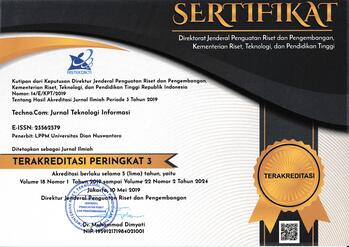Perbandingan Elemen Diegetik Dan Non Diegetik Terhadap Game Experience Pada Game Matematika
Abstract
Kegiatan pembelajaran yang dilakukan secara daring atau School From Home (SFH) melibatkan banyak pihak untuk memudahkan para siswa dalam belajar. Banyak media atau aplikasi game yang dibuat untuk proses belajar mengajar para siswa seperti aplikasi game edukasi pada mata pelajaran matematika. Penelitian ini bertujuan untuk menganalisa dan membandingkan pengalaman bermain game pada elemen diegetik dan non diegetik terhadap game matematika. Metode penelitian dalam membandingkan game ini menggunakan metode CEGE yang terdiri dari beberapa bagian yaitu enjoyment, frustration, Puppetry, dan bagian Video-Game. Pengujian dilakukan dengan mengisi kuesioner yang berjumlah 38 pertanyaan terhadap 22 responden. Berdasarkan hasil pengujian, sebagian besar pengguna memilih game dengan elemen diegetik pada skala enjoyment dengan nilai 16 dan CEGE dengan nilai 146, sedangkan pada game non diegetik sebagian besar memilih pada skala video-game (environment) dengan nilai 29. Sehingga hasil penelitian ini menunjukkan bahwa user lebih banyak menggunakan elemen diegetik.
Keywords
Full Text:
PDFReferences
* Fernindia, E. Sabtaningrum, I. Wiyokusumo, and I. P. Leksono, “E-book Tematik Terpadu Berbasis Multikultural Ddlam Kegiatan SFH (School from Home),” J. Ilm. Sekol. Dasar, vol. 4, no. 2, pp. 153–162, Jul. 2020, doi: 10.23887/JISD.V4I2.24796.
I. Rahmawati, I. Priono Leksono, A. Buana Surabaya Abstrak, and J. Kajian, “Pengembangan Game Petualang untuk Pembelajaran Berhitung,” Edcomtech J. Kaji. Teknol. Pendidik., vol. 5, no. 1, pp. 11–23, Apr. 2020, doi: 10.17977/UM039V5I12020P011.
M. Jenkins, J. Hanson, and L. G. Centre, “A guide for senior managers,” p. 23, 2003, Accessed: Jul. 01, 2022. [Online]. Available: http://books.google.com/books?id=6c6GPgAACAAJ&pgis=1.
P. Suciati and A. Syafiq, “School From Home (SFH): Perjuangan Para Orang Tua Siswa Usia Dini Di Masa Pandemi Covid-19,” J. Sos. Hum. Terap., vol. 3, no. 2, p. 2021, Jul. 2021, doi: 10.7454/JSHT.V3I2.129.
F. Firman and S. Rahayu, “Pembelajaran Online di Tengah Pandemi Covid-19,” Indones. J. Educ. Sci., vol. 2, no. 2, pp. 81–89, Apr. 2020, doi: 10.31605/IJES.V2I2.659.
Y. C. Kuo, A. E. Walker, K. E. E. Schroder, and B. R. Belland, “Interaction, Internet self-efficacy, and self-regulated learning as predictors of student satisfaction in online education courses,” Internet High. Educ., vol. 20, pp. 35–50, 2014, doi: 10.1016/J.IHEDUC.2013.10.001.
“Educational Apps: E-Learning Market Research And Statistics | Shakuro.” https://shakuro.com/blog/educational-apps-e-learning-market-research-and-statistics (accessed Jul. 01, 2022).
“• Global mobile education app downloads by platforms 2020 | Statista.” https://www.statista.com/statistics/1128262/mobile-education-app-downloads-worldwide-platforms-millions/ (accessed Jul. 01, 2022).
“Top Education Apps Worldwide for August 2020 by Downloads.” https://sensortower.com/blog/top-education-apps-worldwide-august-2020 (accessed Jul. 01, 2022).
“Game – Jenis Aplikasi Mobile yang Paling Populer | Arieffitrobagindo’s Blog.” https://arieffitrobagindo.wordpress.com/2012/11/30/game-jenis-aplikasi-mobile-yang-paling-populer/ (accessed Jul. 01, 2022).
“DESAIN GAME EDUKASI BONGKAR PASANG | FKIP e-PROCEEDING.” https://jurnal.unej.ac.id/index.php/fkip-epro/article/view/9362 (accessed Mar. 08, 2022).
“ANALISIS IMPLEMENTASI GAME EDUKASI ‘THE HERO DIPONEGORO’ GUNA MENINGKATKAN HASIL BELAJAR SISWA DI MTS. ATTAROQIE MALANG | Teknologi Informasi : Teori, Konsep, dan Implementasi : Jurnal Ilmiah.” http://ejurnal.stimata.ac.id/index.php?journal=TI&page=article&op=view&path%5B%5D=248 (accessed Mar. 08, 2022).
“MEMBANGUN APLIKASI GAME EDUKATIF SEBAGAI MEDIA BELAJAR ANAK-ANAK | Rohman | JURNAL COMPUTECH & BISNIS.” http://jurnal.stmik-mi.ac.id/index.php/jcb/article/view/51/46 (accessed Mar. 08, 2022).
M. Peacocke, R. J. Teather, J. Carette, I. S. MacKenzie, and V. McArthur, “An empirical comparison of first-person shooter information displays: HUDs, diegetic displays, and spatial representations,” Entertain. Comput., vol. 26, pp. 41–58, May 2018, doi: 10.1016/J.ENTCOM.2018.01.003.
“View of Perancangan Motion Graphics ‘Dampak Bermain Gadget’ Sebagai Media Edukasi Orang Tua Usia 30 – 40 Tahun.” https://jom.fikom.budiluhur.ac.id/index.php/Pantarei/article/view/410/317 (accessed Mar. 16, 2022).
I. Iacovides, A. Cox, R. Kennedy, P. Cairns, and C. Jennett, “Removing the HUD: The impact of non-diegetic game elements and expertise on player involvement,” CHI Play 2015 - Proc. 2015 Annu. Symp. Comput. Interact. Play, pp. 13–22, Oct. 2015, doi: 10.1145/2793107.2793120.
N. Lane and N. R. Prestopnik, “Diegetic connectivity: Blending work and play with storytelling in serious games,” CHI Play 2017 - Proc. Annu. Symp. Comput. Interact. Play, pp. 229–239, Oct. 2017, doi: 10.1145/3116595.3116630.
J. Li, E. Van Der Spek, J. Hu, and L. Feijs, “Exploring tangible interaction and diegetic feedback in an ar math game for children,” Proc. 18th ACM Int. Conf. Interact. Des. Child. IDC 2019, pp. 580–585, Jun. 2019, doi: 10.1145/3311927.3325333.
J. Li, E. D. Van Der Spek, J. Hu, and L. Feijs, “Turning your book into a game: Improving motivation through tangible interaction and diegetic feedback in an AR mathematics game for children,” CHI Play 2019 - Proc. Annu. Symp. Comput. Interact. Play, pp. 73–85, Oct. 2019, doi: 10.1145/3311350.3347174.
A. Al Mahmud, O. Mubin, S. Shahid, and J. B. Martens, “Designing and evaluating the tabletop game experience for senior citizens,” ACM Int. Conf. Proceeding Ser., vol. 358, pp. 403–406, 2008, doi: 10.1145/1463160.1463205.
N. E. Fahmi et al., “IDENTIFIKASI PENGALAMAN BERMAIN GAME MOBILE (STUDI KASUS GAME CLASH OF CLANS),” J. Sosioteknologi, vol. 17, no. 2, pp. 246–260, Sep. 2018, doi: 10.5614/SOSTEK.ITBJ.2018.17.2.7.
L. Pfister and S. Ghellal, “Exploring the influence of non-diegetic and diegetic elements on the immersion of 2D games,” ACM Int. Conf. Proceeding Ser., pp. 490–494, Dec. 2018, doi: 10.1145/3292147.3292190.
E. H. Calvillo-Gámez, P. Cairns, and A. L. Cox, “Assessing the Core Elements of the Gaming Experience,” pp. 37–62, 2015, doi: 10.1007/978-3-319-15985-0_3.
E. H. Calvillo Gamez, “On the core elements of the experience of playing video games,” Dr. thesis, UCL (University Coll. London). , 2009.
D. Herumurti, A. Yuniarti, W. N. Khotimah, I. Kuswardayan, F. Revindasari, and S. Arifiani, “Analysing the user experience design based on game controller and interface,” 2018 Int. Conf. Signals Syst. ICSigSys 2018 - Proc., pp. 136–141, Jun. 2018, doi: 10.1109/ICSIGSYS.2018.8372653.
N. Xahan Chamok, M. Ikbal Hossain, P. Paul, I. Jahan Labonno, and M. Atiqur Rahman Shujon, “Game-based Storytelling Using Role Playing Game and Expansion to Virtual Reality,” Accessed: Aug. 22, 2022. [Online]. Available: www.diverseresearchjournals.com.
DOI: https://doi.org/10.33633/tc.v21i4.6959
Article Metrics
Abstract view : 160 timesPDF - 108 times
Refbacks
- There are currently no refbacks.
Diterbitkan Oleh :
Jurnal Techno.Com terindex di :
Jurnal Teknologi Informasi Techno.Com (p-ISSN : 1412-2693, e-ISSN : 2356-2579) diterbitkan oleh LPPM Universitas Dian Nuswantoro Semarang. Jurnal ini di bawah lisensi Creative Commons Attribution 4.0 International License.













